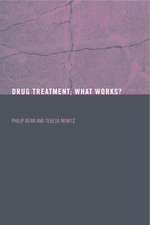Drug Use in Australia: Preventing Harm
Autor Margaret Hamilton, Trevor King, Alison Ritteren Limba Engleză Paperback – 4 feb 2004
Structured in two parts, Part I outlines the biosocial and cultural context of drug use, while Part II deals with the various ways in which a harm-minimisation approach can be used in responding to drug use (the harm-minimisation perspective recognises that safety should be the first priority in dealing with the use of both legal and illicit drugs). The book concludes with a critical reflection on the limits of harm minimisation, a discussion of emerging areas of importance such as drugs in sport, and a glossary of key terms. By challenging prevailing and often simplistic views about drugs and drug use in Australia, the book is often provocative and always engaging. Written for undergraduate and graduate students undertaking drug and alcohol studies, as well as for practitioners working in public health and allied disciplines such as welfare and law enforcement. Drug Use in Australia offers long-ranging and unique insights into contemporary and future issues such as the changing nature of drugs and drug use in this digital age.
Preț: 405.36 lei
Nou
Puncte Express: 608
Preț estimativ în valută:
77.56€ • 81.28$ • 64.12£
77.56€ • 81.28$ • 64.12£
Carte tipărită la comandă
Livrare economică 10-16 aprilie
Preluare comenzi: 021 569.72.76
Specificații
ISBN-13: 9780195514803
ISBN-10: 0195514807
Pagini: 336
Dimensiuni: 152 x 228 x 19 mm
Greutate: 0.49 kg
Ediția:Second.
Editura: Oxford University Press
Colecția OUP Australia & New Zealand
Locul publicării:Melbourne, Australia
ISBN-10: 0195514807
Pagini: 336
Dimensiuni: 152 x 228 x 19 mm
Greutate: 0.49 kg
Ediția:Second.
Editura: Oxford University Press
Colecția OUP Australia & New Zealand
Locul publicării:Melbourne, Australia
Descriere
Drug Use in Australia describes policy, prevention and treatment responses to drug use, and details the social and political implications of these approaches. Key sociological, historical and psychological theories are described, with attention to social groups such as aboriginal people, young people and women. The book also examines the major policy and institutional responses, including recent treatment, educational, and policy developments.Structured in two parts, Part I outlines the biosocial and cultural context of drug use, while Part II deals with the various ways in which a harm-minimisation approach can be used in responding to drug use (the harm-minimisation perspective recognises that safety should be the first priority in dealing with the use of both legal and illicit drugs). The book concludes with a critical reflection on the limits of harm minimisation, a discussion of emerging areas of importance such as drugs insport, and a glossary of key terms. By challenging prevailing and often simplistic views about drugs and drug use in Australia, the book is often provocative and always engaging. Written for undergraduate and graduate students undertaking drug and alcohol studies, as well as for practitioners workingin public health and allied disciplines such as welfare and law enforcement, Drug Use in Australia offers long-ranging and unique insights into contemporary and future issues such as the changing nature of drugs and drug use in this digital age.

















